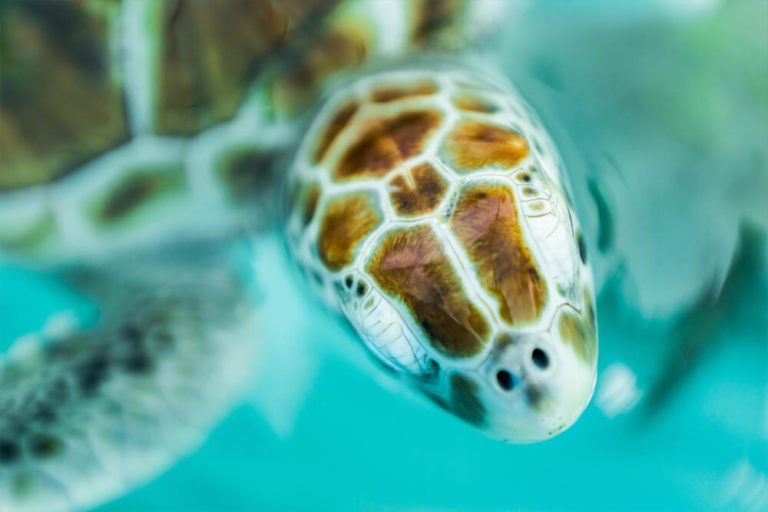Species Spotlight: Sea Turtles

When you think about the ocean, sea turtles are probably one of the first aquatic animals that come to mind. They’re mellow in nature and vital to our ecosystem—plus, they’re downright cute.
There are only seven types of sea turtles, six of which have a hard shell (the seventh being the Leatherback Turtle, which, as its name implies, feels more like leather than a shell). Because most turtles are almost entirely protected by this tough exterior, they don’t have a lot of predators—once they’ve reached adulthood, that is—and can live to be up to 100 years old (we’ve basically put plastic straws out of business because of the harm they’ve caused on this majestic species).
UNIQUE FACTS ABOUT SEA TURTLES
-
Sea turtles are one of the oldest known species, having been around for over 110 million years—they once shared the world with dinosaurs.
-
They cannot retract their head or flippers into their shells like turtles you might find with a turtle from a fresh-water lake or pond. Because they have very few predators, their anatomy has changed over the years to make them more agile in the water. Unfortunately, this makes them very vulnerable when first born.
-
Turtles need air! While they spend the majority of their time beneath the surface, turtles are reptiles who need to come up for air roughly every five hours. In order to hold their breath for such long stints, sea turtles have adapted the technique of slowing their heartbeat, some beat only once every nine minutes.
-
The diet of sea turtles changes as they grow. As adolescents, sea turtles are omnivores, eating everything from seaweed to worms and fish. With age, however, they become exclusively herbivores—except the leatherback turtle which eats jellyfish.
-
Only one in every 1,000 baby sea turtles will live to adulthood, most don’t even make it to the sea after hatching with an array of preditors on land including gulls and raccoons. The odds don’t get much better if they hit the water, either, with sharks and large fish in constant search of an easy meal.
BEST PLACES TO SEE A SEA TURTLE IN THE WORLD
-
PLAYA GRANDE, COSTA RICA
-
Playa Grande, one of Costa Rica’s most beautiful beaches, is a great place to see the Leatherback turtle in its natural habitat. This is the largest species of turtle—they can weigh up to 1,500 pounds! Playa Grande is the world’s largest nesting place for Leatherback turtles, so if you visit between October and March, you might even see little newborns making their way to the water from a nesting site.
-
-
LANIAKEA BEACH, HAWAII
-
Otherwise known as “Turtle Beach,” this spot is located on the northern coast of Oahu, just an hour’s drive from Honolulu. Green turtles flock to this spot year-round to snack on seaweed and enjoy the sun. We suggest visiting any season besides winter—sometimes the waves are rough and choppy, deterring the turtles from paying the beach a visit.
-
-
GILI ISLANDS, INDONESIA
-
The Gili Islands, in particular, are a beautiful, tropical home to the Green and Hawksbill turtles. The Hawksbill turtle is endangered but stunningly beautiful, with a colorful shell that distinguishes it from other species of turtle. Whether you’re interested in scuba diving or snorkeling, you’ll most likely come across these two species of turtle between the months of March and September.
-
-
HERON ISLAND, AUSTRALIA
-
Heron Island is home to six out of the seven species of turtle, including the Hawksbill, Green, Olive Ridley, Flatback and Loggerhead. This island is just south of the Great Barrier Reef, and from spring to fall you’ll find them nesting along the coast—you can even schedule tours to see them up close and personal.
-
-
OAXACA, MEXICO
-
The Sociedad Cooperativa El Santuaria de la Tortuga is the largest turtle sanctuary and nesting place for the Olive Ridley turtle. To see a mother nesting, the best time to visit is July, however, the baby turtles hatch between August and October.
-
HOW YOU CAN HELP
Every day, we’re unknowingly destroying the turtle’s natural habitat with an excess of plastics and other debris that are choking and entangling turtles while damaging the ecosystem. We encourage you to be conscious of your ecological footprint and minimizing your waste by carrying reusable bags and water bottles and finding alternatives to plastics.
If you do visit a turtle nesting spot, do not interrupt the animals with flashlights and other annoyances, and be sure to remove any beach equipment like chairs and umbrellas. Also, try to fill in any man-made holes and destructure sandcastles to help the new hatchlings make their journey to the sea a little easier.
